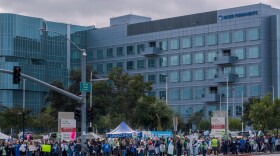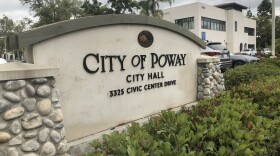A new element has joined the flood of migrants clamoring to get into the United States — Nicaraguans fleeing their homeland's political unrest and violence.
In recent years, Nicaraguans had been only a small drop in the wave of Central Americans trying to migrate to the U.S., mostly from the poor and crime-wracked nations of Honduras, Guatemala and El Salvador.
Now physicians, taxi drivers and other Nicaraguans are streaming in and applying for asylum or at least temporary protection, saying they fear they will be persecuted if forced to return home.
"I left Nicaragua because of the repression, the harassment, the intimidation I was under," said Luis Rodolfo Ibarra Zeledon, a family doctor who says he was targeted for helping injured protesters. "If I had stayed, it is likely that they would have made me disappear somewhere."
RELATED: New Migrant Caravan Sets Out From Honduras For US
Nicaragua erupted in turmoil last April after the government announced a plan to cut social security benefits. Widespread protests caused the government to back down on reducing pensions, but the demonstrations grew and evolved into a movement demanding Ortega step down after 11 years in power.
Ortega called it a U.S.-supported coup attempt, and his government and allies cracked down on protests, resulting in more than 300 people being killed, according to the Inter-American Commission on Human Rights. Some non-governmental groups estimate more than 500 died.
While clashes have subsided, the country of 6 million people is tangled in its worst political crisis since civil war in the 1980s. Tens of thousands of people have left. According to the U.N., a large majority — at least 29,000 — fled to Costa Rica.
Some have made their way to the U.S. by plane with existing tourist visas, staying for weeks or months to see if conditions improve at home. Others cross the border from Mexico illegally, then surrender to U.S. officials and ask for asylum.
The newcomers join 444,500 Nicaraguan nationals already living in the United States, primarily in Florida and California. Most of those fled the 1977-1990 civil war or the devastation of Hurricane Mitch in 1998.
"Since April there has been a tremendous increase" of Nicaraguans, said Alfonso Oviedo Reyes, an immigration lawyer who has been offering asylum advice at public libraries in south Florida during weekends.
They are reaching the U.S. at a difficult time for migrants.
President Donald Trump's administration recently said it was ending a program that allowed earlier Nicaraguan migrants to live in the U.S. temporarily, putting more than 5,000 at risk of deportation.
RELATED: Mexico: US To Send Back 20 Migrants Daily In New Asylum Plan
It has also imposed tough new rules on asylum seekers in general, though at the same time, it has strongly accused Ortega's government of human rights abuses and imposed financial sanctions on high-level Nicaraguan officials.
Ibarra, the family physician, was at a detention center in Arizona for almost three months after entering illegally from Mexico at the end of September and immediately requesting asylum. He was released in December, when two American friends put up $28,500 in bail and offered to let him live in their house in central Florida.
Ibarra said by telephone that he decided to flee after receiving death threats. One was a 24-second video sent via WhatsApp showing armed men in military camouflage along with images of Ibarra, his wife, their baby daughter and his mother. A male voice says they are awaiting orders to "settle scores."
Ibarra said he was targeted because he assisted injured protesters at his home in the northern Nicaragua city of Esteli. At one point, masked men pulled him out of an ambulance, beat him and dumped him in a field, he said.
"I had a life, a good salary, a good job, a house, food," Ibarra said. "I never thought I would come to the U.S. I enjoyed living in my country."
He said he hopes his wife and 1-year-old daughter can join him in the U.S.
Though there are few hard statistics yet for the past few months, the Department of Homeland Security has seen a jump in detentions of Nicaraguans trying to enter the U.S. illegally from Mexico.
About 1,000 Nicaraguans were detained along the U.S. border with Mexico in the full 12 months from October 2016 through September 2017 — a fairly typical number for recent years. But at just one point recently, the department was holding 1,300 Nicaraguans newly caught at the southern border— a figure that doesn't include those released on bond or deported.
New asylum applications filed by Nicaraguans in immigration courts rose from 351 in fiscal year 2016 to 599 the following year and 654 in the latest fiscal year.
"Previously we nearly never saw Nicaraguan asylum seekers," said Alan Dicker of the Detained Migrant Solidarity Committee in El Paso, Texas, which helps detained migrants pay bail. "We have received numerous requests to post bonds for Nicaraguans."
That increased flow is going to continue, predicts Charles Ripley, a political science professor at Arizona State University who lived in Nicaragua for eight years and visited the country in June.
"The economy has been decimated. These are people who are fearful of the government, but most importantly, there is an economic refugee problem. People are losing jobs left and right in Nicaragua," Ripley said.
Asylum is what Luis Antonio Campos Manzanares, a taxi driver, has in mind. He says that after he joined protests in the central Nicaraguan town of Boaco, he was pursued and threatened by police and government supporters.
"I did not know what to do," he said while showing a picture of an uncle whose bloodied face he said was inflicted by pro-government activists. "We came here looking for some help. We can't go back because they will kill us."
In July, he crossed the border and surrendered to Border Patrol officers. He was released from detention in October after paying a $12,000 bond with money his family put together. Wearing an electronic ankle monitor, he lives in Miami with his mother, Reina Manzanares, a housewife who fled their homeland three years ago and has requested political asylum.
Also seeking asylum are Darling Perez, her husband and 12-month-old baby, all of whom arrived in the U.S. on tourist visas.
Perez was a pediatrician at a public hospital in the central province of Chontales and was told not to treat protesters when the disturbances broke out. She said she was fired by the hospital after she began helping wounded students at private clinics and also openly criticized the government on social media.
She said she popped up on a "Wanted" poster showing people involved in the protests. Two of the 30 people on the poster have been detained, while others are in hiding or have fled Nicaragua, she said.
"I am in posters like if I were a terrorist," Perez said. "I can't go back in there."






